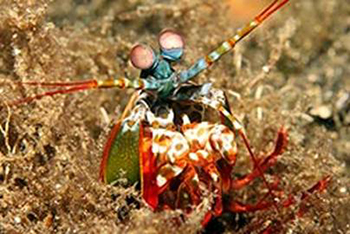Mantis Shrimp
Squilla empusa

TAXONOMY
Kingdom Animalia
Phylum Arthropoda
Subphylum Crustacea
Class Malacostraca
Subclass Hoplocarida
Order Stomatopoda
DESCRIPTION
A Mantis shrimp is a marine crustacean that can grow to almost 12 inches in length, and in some rare cases they can grow to 15 inches. It’s not actually a shrimp at all, but gets its name because it resembles a praying mantis, and a shrimp. They have a unique set of “thumb splitters” or small appendages that they use to break or crack open shells of other crustaceans to retrieve food and nutrients. They are the fastest known organism due to their quick jabbing appendages that can reach up to 170 mph. They also come in a variety of different colors, as seen in the picture above.
HABITAT
Mantis shrimp are usually found in shallow tropical or subtropical waters, with some species occasionally found in sub-Antarctic waters. They are found along shores, usually living in an abandoned burrow to move in and out to capture prey when spotted. They can also live in coral reefs or rock crevices.
BEHAVIOR
The Mantis shrimp is a fierce competitor in the places they inhabit. They have very powerful, color sensing eyes that sit up on stalks that allow them to search for food and even to escape other predators. Their array of bright colors is flashed to warn other organisms that they are ready to strike, and to prevent themselves from getting hurt or killed.
REPRODUCTION
Some species of mantis shrimp can actually mate with a partner, and stay together for their entire life. However, most mantis shrimp mate with many different partners. They do this by sexual reproduction, where the male exhibits a unique courtship signaling his intentions. They then come together, the male transfers the sperm to the female where she can either retain the fertilized eggs, or lay them immediately in her burrow or crevice, or they can keep them on their forelimbs.
DIET
Mantis shrimp are very quick and deadly predators, which prey on crustaceans such as clams, fish, or other small invertebrates. They can either pierce or smash their prey with their fierce appendages. They can pierce the soft shell of a fish, or smash and break open the shell of a clam to retrieve the soft tissue.
ECOLOGY
The Mantis shrimp spends most of their life living in their burrow, only coming out to mate or hunt for food. They are an ecological importance to coral reefs because they are very sensitive to environmental pollutants, so their behavior indicates when conditions are poor. They also eat many organisms that feed on the coral reefs.
PERSONAL INTEREST
I chose the Mantis shrimp because I think they are one of the coolest animals on the planet. For such a small organism to pack such a powerful punch is amazing. They are even known to break aquariums, and some species possess many different colors making them very extravagant.
REFERENCES
Please note that the following references may have either been removed or relocated by the webpage owners since the time this student report was created.
http://www.mesa.edu.au/AtoZ/Mantis_shrimp.asp
http://www.bbc.co.uk/nature/blueplanet/factfiles/crustaceans/mantis_shrimp_bg.shtml
http://www.nightsea.com/mantis.htm
http://www.coralscience.org/main/articles/reef-species-4/stomatopods
http://politicalecology.xyvy.info/ecological-role-of-stomatopods-mantis-shrimps-and-potential-impacts-of-trawling-in-a-marine-ecosystem-of-the-southeast-coast-of-india/